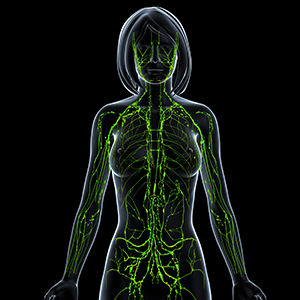Lymphedema and Cancer

Lymphedema is a serious condition in which an arm or leg swells with fluid, causing discomfort and pain. It gets worse over time. In advanced stages, it may lead to infection or stop you from fully using your limb.
Important things to know:
- Lymphedema is sometimes caused by cancer and cancer treatment.
- It occurs in about 20% of breast cancer patients.
- You can take steps to stop it from getting worse.
- The sooner you take action, the better.
- The OHSU Knight Cancer Institute has dedicated lymphedema therapists to help you.
Understanding lymphedema
What is lymphedema?
Lymphedema is a condition in which an arm or leg fills with a fluid called lymph. This leads to swelling, discomfort and pain.
Lymph is a clear fluid that contains white blood cells and immune cells. It is an important part of your immune system and helps you fight infection and disease. Lymph circulates through a network of organs, vessels and nodes called the lymphatic system.

Lymph nodes are the workhorses of the system. Shaped like beans, they are located through the body, clustering around your neck, armpit and groin. They circulate and filter your lymph fluid. They trap bacteria and other tiny invaders. They also trap cancer cells.
If cancer spreads to your lymph nodes, doctors may need to remove some of them. Removing nodes can clog the system. The lymph doesn’t drain right and starts to build up, like a traffic jam when a bridge is raised. This is lymphedema.
Some types of cancer and cancer treatment, like radiation therapy or chemotherapy, can also block your lymph nodes.
Lymphedema typically occurs in an arm or leg. The limb feels hard, swollen and heavy. In advanced cases, lymphedema can lead to thickening of the skin, and can put you at risk of infection. It may also prevent you from fully using your arm or leg.
Lymphedema occurs in about 20% of patients who have been treated for breast cancer.
Patients are at their highest risk within three years of treatment, though it can occur any time afterward.
Lymphedema symptoms
These symptoms can also be caused by other conditions.
- Swelling in your arm or leg
- Swelling in your fingers or toes
- An arm or leg that feels heavy
- A feeling of tightness in the skin
- Itching or burning sensation
- Thickening of the skin
Diagnosing lymphedema
Your care team may use several tests and tools to diagnose lymphedema:
- Physical exam and medical history.
- MRI scan: Magnetic resonance imaging scans take pictures of your insides. MRI scans are noninvasive. You lie on a scanner and hold still. The scanner uses a large magnet, radio waves and sophisticated computers.
- Bioimpedance scan: This a quick and painless way to measure the fluid distribution in your body. You stand on a scale and put your hands on a sensor. The sensor reads electric signals that travel through your legs and arms. Find out more about bioimpedance scans.
- Lymphoscintigraphy: Creates a detailed map of your lymph nodes using a small amount of radioactive dye and a special camera. Find out more about lymphoscintigraphy.
Lymphedema treatment
Lymphedema is easier to treat when it’s caught early. Conservative measures such as physical therapy and compression can help you avoid surgery.
Your treatment depends on many factors. Every patient is unique. Lymphedema therapists at the OHSU Rehabilitation Center will guide you through treatment.
Exercise
Exercise has many benefits for cancer patients. It plays a key role in treating lymphedema. Gentle stretching can loosen areas that feel tight, hard or heavy. Light weightlifting can improve muscle tone, help the fluid circulate and reduce the risk of flare-ups.
A lymphedema therapist can help you come up with an exercise program. It is vital to start easy and go slow.

a lymphedema therapist to come up with a plan.
Massage
Massage can reduce fluid buildup:
- Manual lymphatic drainage can release fluid from your tissue and help it get reabsorbed by the lymph nodes.
- Soft-tissue massage can help loosen scar tissue to relieve discomfort and reduce swelling.
Compression
Your care team may suggest bandages or compression garments that put pressure on your arm, leg or torso. Compression can keep fluid circulating. For example, a sleeve may be tighter near the wrist and looser near the shoulder. That helps guide the fluid to travel up the arm.
Surgery
We expect to resume surgery for lymphedema in 2024. Surgical procedures for this condition include:
- Lymphovenous bypass
- Vascularized lymph node transfer
- Liposuction debulking
Living with cancer
At the Knight Cancer Institute, we treat the person as well as the disease. Check out the resources we offer to support patients and families.
Learn more
- Lymphatic Education and Research Network
- Lymphedema, BreastCancer.org
For patients
- If you notice signs of lymphedema, talk with your care team. They can make sure you get the services you need.
Refer a patient
- Refer your patient to OHSU.
- Call 503-494-4567 to seek provider-to-provider advice.
Location
Knight Cancer Institute, South Waterfront
Center for Health & Healing, Building 1
3303 S.W. Bond Ave.
Portland, OR 97239
Free parking for patients and visitors